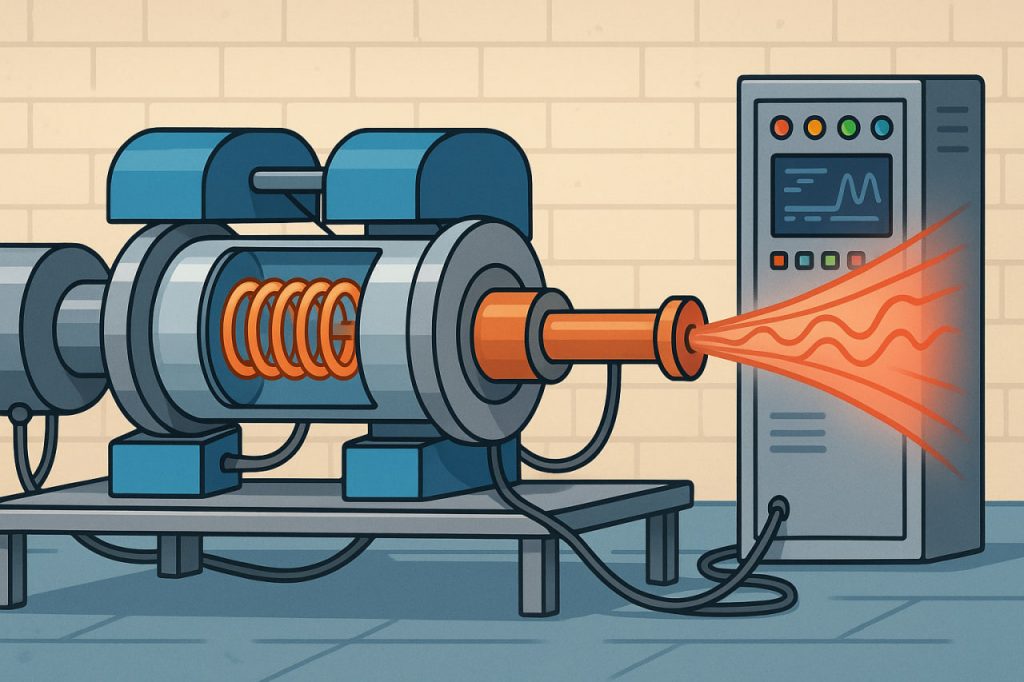A gyrotron is a high-power vacuum tube that generates electromagnetic radiation in the millimeter-wave and sub-terahertz frequency ranges. It belongs to the class of cyclotron resonance masers, meaning it amplifies radiation by interacting with fast-moving electrons spiraling in a magnetic field. Gyrotrons are primarily used in advanced scientific and industrial applications that require intense, focused beams of energy, especially in the field of nuclear fusion research.
Principle of Operation
The gyrotron operates by converting the kinetic energy of electrons into high-frequency electromagnetic waves. Electrons are emitted from a cathode and accelerated into a strong magnetic field, where they follow a helical or spiral path. This motion causes the electrons to emit radiation at a frequency determined by the cyclotron frequency—a function of the electron’s speed and magnetic field strength.
Unlike traditional microwave sources such as klystrons or magnetrons, the gyrotron can achieve frequencies in the 30–300 GHz range or higher, with continuous-wave power output reaching hundreds of kilowatts. The electron beam travels through a resonant cavity, where it interacts with the electromagnetic field, amplifying it before the wave is extracted via a waveguide.
Applications in Fusion Energy
One of the primary uses of gyrotrons is in magnetic confinement fusion reactors like tokamaks and stellarators. In these devices, extremely hot plasmas—reaching over 100 million degrees Celsius—must be sustained and controlled. Gyrotrons provide the electron cyclotron resonance heating (ECRH) required to heat and stabilize these plasmas using focused beams of millimeter-wave radiation.
The gyrotron’s ability to deliver high-frequency energy with high efficiency and directional control makes it indispensable for ongoing projects like ITER (International Thermonuclear Experimental Reactor). It also supports plasma diagnostics and stabilization by suppressing magnetohydrodynamic instabilities.
Industrial and Scientific Applications
Beyond fusion energy, gyrotrons are used in materials processing, plasma chemistry, and dielectric heating. They enable uniform heating of ceramics, semiconductors, and advanced composites, especially in situations where conventional methods fail due to depth or precision limitations.
In atmospheric science and remote sensing, gyrotron-based systems can be employed in spectroscopy to study high-resolution molecular transitions. They are also being explored in security screening, biomedical imaging, and telecommunications in experimental ultra-high-frequency systems.
Design Challenges and Advancements
Despite their advantages, gyrotrons are technically complex and expensive to produce. They require powerful superconducting magnets, ultra-high-vacuum chambers, and sophisticated cooling systems. Stability of frequency and beam control are critical for effective operation.
Advances in gyrotron efficiency, frequency tunability, and compactness are areas of active research. Scientists are working to miniaturize components, enhance reliability, and broaden their range of applications through solid-state controls and adaptive waveguide designs.
Comparison to Other High-Frequency Sources
Compared to devices like masers, klystrons, or free-electron lasers, the gyrotron stands out for its ability to generate extremely high-power continuous-wave radiation at sub-terahertz frequencies. While masers are limited in power and cryogenic conditions, and klystrons have lower frequency capabilities, the gyrotron fills a unique niche at the frontier of microwave and terahertz technology.
Its combination of high frequency, high power, and continuous operation makes it a leading candidate for tasks requiring deep penetration, tight focusing, and high-energy delivery over time.
Conclusion
The gyrotron is a sophisticated device that plays a crucial role in modern science and technology. From heating plasma in fusion reactors to enabling precision industrial processing, its capabilities extend beyond those of conventional microwave sources. Though complex and resource-intensive, continued innovation in gyrotron technology promises new possibilities in energy, materials science, and communications.
Glossary
- Gyrotron — a vacuum tube that generates high-frequency electromagnetic radiation via cyclotron resonance.
- Millimeter-wave — electromagnetic waves with wavelengths between 1–10 mm (30–300 GHz).
- Cyclotron frequency — the rate at which charged particles spiral in a magnetic field.
- Electron cyclotron resonance heating (ECRH) — plasma heating method using millimeter-wave radiation.
- Tokamak — a device that uses magnetic fields to confine plasma in nuclear fusion research.
- Waveguide — a structure that guides electromagnetic waves from one point to another.
- Superconducting magnet — a magnet made from superconducting materials capable of generating intense magnetic fields.
- Masers and klystrons — older vacuum tube technologies for generating microwave radiation.



its good as your other blog posts : D, appreciate it for posting.
Thanks for this post, I am a big fan of this internet site would like to proceed updated.